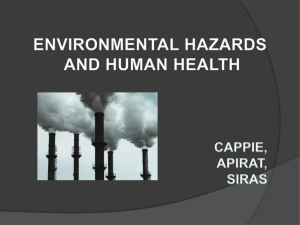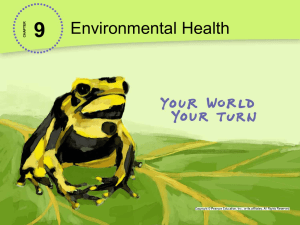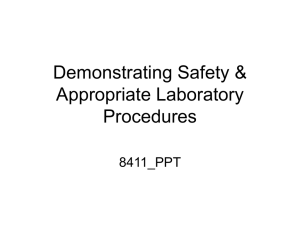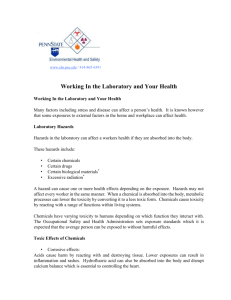apes ch 17 environmental hazards sem 2
advertisement
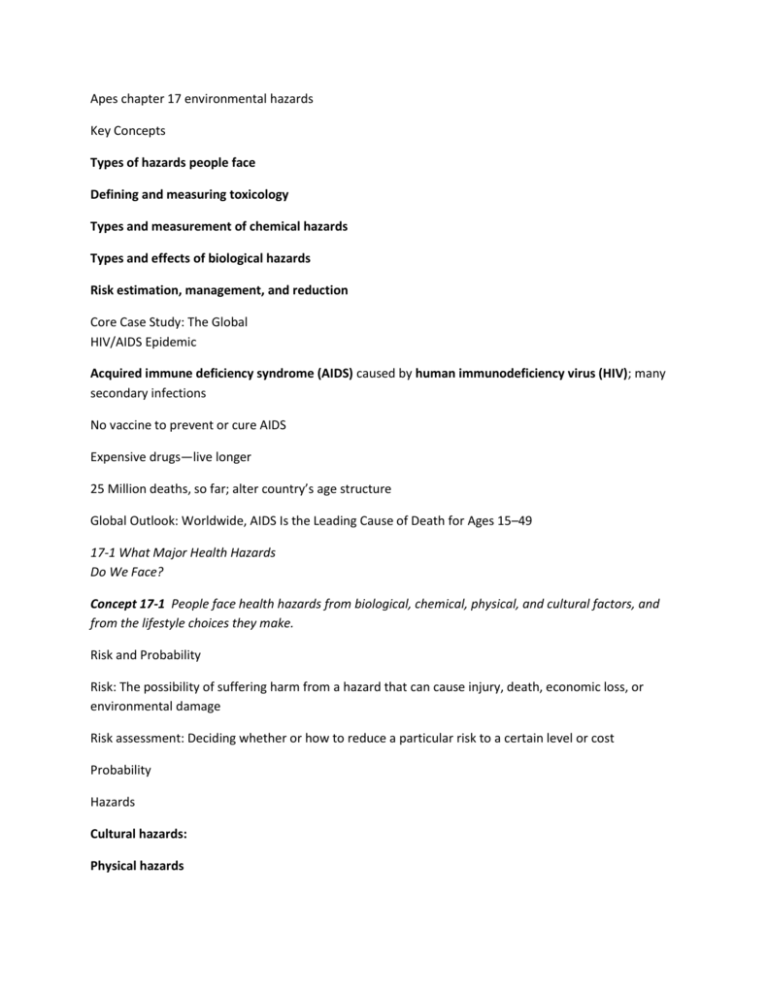
Apes chapter 17 environmental hazards Key Concepts Types of hazards people face Defining and measuring toxicology Types and measurement of chemical hazards Types and effects of biological hazards Risk estimation, management, and reduction Core Case Study: The Global HIV/AIDS Epidemic Acquired immune deficiency syndrome (AIDS) caused by human immunodeficiency virus (HIV); many secondary infections No vaccine to prevent or cure AIDS Expensive drugs—live longer 25 Million deaths, so far; alter country’s age structure Global Outlook: Worldwide, AIDS Is the Leading Cause of Death for Ages 15–49 17-1 What Major Health Hazards Do We Face? Concept 17-1 People face health hazards from biological, chemical, physical, and cultural factors, and from the lifestyle choices they make. Risk and Probability Risk: The possibility of suffering harm from a hazard that can cause injury, death, economic loss, or environmental damage Risk assessment: Deciding whether or how to reduce a particular risk to a certain level or cost Probability Hazards Cultural hazards: Physical hazards Chemical hazards Biological hazards Lifestyle choices 17-2 What Types of Biological Hazards Do We Face? Concept 17-2 In terms of death rates, the most serious infectious diseases are flu, AIDS, diarrheal diseases, malaria, and tuberculosis; most of these deaths occur in developing countries. Biological Hazards: Diseases Nontransmissible disease Transmissible disease Pathogens Vectors Tuberculosis HIV/AIDS Malaria Some Diseases Can Spread from One Person to Another Nontransmissible disease Infectious disease Transmissible disease (contagious or communicable disease) Some Diseases Can Spread from One Person to Another Since 1950, death from infectious diseases have declined due to Better health care Antibiotics Vaccines Disability-adjusted life years (DALYs) Infectious Diseases Are Still Major Health Threats Infectious diseases spread through Air Water Food Body fluids Epidemics and pandemics Resistance of bacteria and insects Science: Pathways for Infectious Diseases in Humans The World’s Seven Deadliest Infectious Diseases Kill 12.5 Million People Science Focus: Genetic Resistance to Antibiotics Is Increasing Bacteria: rapid reproduction, easily spread Over use of antibiotics Methicillin-resistant Staphylococcus aureus (MRSA) Resistant to most antibiotics Symptoms of MRSA How will it be controlled? Over use of pesticides Case Study: The Growing Global Threat from Tuberculosis Why is tuberculosis on the rise? Not enough screening and control programs Genetic resistance to a majority of effective antibiotics Person-to-person contact has increased AIDS individuals are very susceptible to TB Some Viral Diseases Kill Large Numbers of People Influenza or flu virus #1 Killer Transmission HIV #2 Killer Antiviral drugs Some Viral Diseases Kill Large Numbers of People Global strategy to slow down the spread of HIV Reduce the number of new infections Concentrate on those most likely to spread HIV Free testing Education for prevention Provide free or low-cost drugs Research Some Viral Diseases Kill Large Numbers of People Hepatitis B virus (HBV) #3 Killer Mode of transmission Viruses that move form animals to humans West Nile virus Severe acute respiratory syndrome (SARS) Reduce chances of infection: Wash your hands Tracking the Spread of Infectious Diseases to Humans from Other Animals Ecological medicine Human practices that encourage the spread of diseases from animals to humans Emerging infections HIV SARS West Nile virus Lyme virus Case Study: Malaria—Death by Parasite-Carrying Mosquitoes Malaria Caused by Plasmodium sp. carried by Anopheles mosquitoes Spread Symptoms Malarial cycle Case Study: Malaria—Death by Parasite-Carrying Mosquitoes Malaria on the rise since 1970 Drug resistant Plasmodium Insecticide resistant mosquitoes Effect of global warming AIDS patients particularly vulnerable Prevention of spread and current research We Can Reduce the Incidence of Infectious Diseases Good news Vaccinations on the rise Oral rehydration therapy Bad news More money needed for medical research in developing countries 17-3 What Types of Chemical Hazards Do We Face? Concept 17-3 There is growing concern about chemicals that can cause birth defects and cancers and disrupt the human immune, nervous, and endocrine systems. Chemical Hazards Toxic chemicals: Chemicals that can cause temporary or permanent damage Hazardous chemicals: Flammable, explosive, irritant, damage skin or lungs, of cause allergic reactions Mutagens: Cause mutations in the DNA Teratogens: Cause birth defects Chemical Hazards Carcinogens: Cause or promote cancer Neurotoxins: Cause nerve damage Hormonally active agents: Disrupt the effects of natural hormones Precautionary principle: Action should be taken if a chemical is believed to be harmful even though there is no scientific evidence yet to support the belief (better to be safe than sorry concept) Case Study: PCBs Are Everywhere—A Legacy from the Past Class of chlorine-containing compounds Very stable Nonflammable Break down slowly in the environment Travel long distances in the air Fat soluble Biomagnification Food chains and webs Banned, but found everywhere Some Chemicals May Affect Our Immune, Nervous, and Endocrine Systems Some natural and synthetic chemicals in the environment can weaken and harm Immune system Nervous system Endocrine system Some Chemicals May Affect Our Immune, Nervous, and Endocrine Systems Hormonally active agents (HAAs) Gender benders Thyroid disrupters Toxic chemicals Phthlates Effects on the endocrine system Science Focus: Mercury’s Toxic Effects Hg: teratogen and potent neurotoxin Once airborne, persistent and not degradable 1/3 from natural sources 2/3 from human activities Enters the food chain: biomagnification Science Focus: Mercury’s Toxic Effects 2007: Hg hotspots identified How are humans exposed? Inhalation: vaporized Hg or particulates of inorganic salts Eating fish with high levels of methylmercury Effects of Hg on humans Who is most at risk? Science Focus: Bisphenol A Estrogen mimic Found in many common products Laboratory findings Effects on human health Should it be banned? 17-4 How Can We Evaluate and Deal with Chemical Hazards? Concept 17-4A Scientists use live laboratory animals, non-animal tests, case reports of poisonings, and epidemiological studies to estimate the toxicity of chemicals, but these methods have limitations. Concept 17-4B Many health scientists call for much greater emphasis on pollution prevention to reduce our exposure to potentially harmful candidates. Toxicology Toxicity: Measure of how harmful a chemical is Water-soluble toxins, oil of fat soluble toxins Dosage: The amount of substance a person has taken Persistence: The ability of a substance to resist breaking down Bioaccumulation: The absorption and storage of toxins in organs and tissue Biomagnification: The increase of toxin levels as they go up the food chain Toxicology Synergistic interaction: Interaction of two or more factors or processes so that the combined effects is greater than the sum of their separate effects Response: The type & amount of damage from a toxin Acute effect: Immediate harmful effect Chronic effect: Permanent or long lasting consequence from a single or repeated exposure Case Study: Protecting Children from Toxic Chemicals Analysis of umbilical cord blood: significance Infants and children more susceptible to the toxic effects of chemicals than adults Eat, drink water, and breathe more per unit of body weight than adults Put their fingers in their mouths Less well-developed immune systems and body detoxification processes Scientists Use Live Lab Animals and Nonanimal Tests to Estimate Toxicity Dose-response curve: median lethal dose (LD50) Nonthreshold dose-response model Threshold dose-response model Can the data be extrapolated to humans? Scientists Use Live Lab Animals and Nonanimal Tests to Estimate Toxicity More humane methods using animals Replace animals with other models Computer simulations Tissue culture and individual animal cells Chicken egg membranes What are the effects of mixtures of potentially toxic chemicals? Poisons Poison: Chemical that adversely effects health by causing injury, illness or death Median lethal dose (LD50): The dose that will kill 50% of the target group Toxicity Ratings and Average Lethal Doses for Humans Dose-Response Curves Nonthreshold: Any dose causes harm Threshold: No effect till a specific dose is reached There Are Other Ways to Estimate the Harmful Effects of Chemicals Case reports and epidemiological studies Limitations of epidemiological studies Too few people tested Length of time Can you link the result with the chemical? Can not be used for new hazards Pollution Prevention and the Precautionary Principle Those introducing a new chemical or new technology would have to follow new strategies A new product is considered harmful until it can be proved to be safe Existing chemicals and technologies that appear to cause significant harm must be removed 2000: global treaty to ban or phase out the dirty dozen (POPs) Individuals Matter: Ray Turner and His Refrigerator 1974: Ozone layer being depleted by chlorofluorocarbons (CFCs) 1992: International agreement to phase out CFCs and other ozone-destroying chemicals Ray Turner: citrus-based solvents to clean circuit boards Bioterrorism Possible targets: air, water, and food Inexpensive Fairly easy to produce biological agents Recombinant DNA techniques Risk Analysis Risk analysis Comparative risk analysis System reliability Risk management Risk perception



